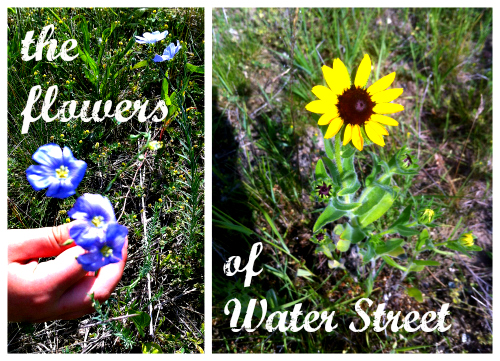The flowers that we planted last May are beginning to open up on the Water Street Prairie. They aren’t quite as plentiful as we’d hoped, which we attribute to the poor quality of the soil, and the continued presence of invasive species like Spotted Knapweed, but the native plants that we reintroduced to the site are trying to fight their way back, and we’re trying, to the best of our ability, to help them get a foothold. (The Black-eyed Susans seem to be doing particularly well.)
As I mentioned a week or so ago, a small crew of us have been busting our asses on Knapweed eradication, but we’re having a difficult time staying ahead of it, which is why I’m writing to you today.
As you may recall from our earlier conversations, not only does Knapweed spread incredibly easily, but, as it tastes terrible, few herbivores want to eat it. Even worse, it has an unusually long tap root, which aggressively sucks water from its neighboring plants, destining them for failure. And, as if that weren’t enough, it’s also thought to be allelopathic, meaning that it releases a toxin from its roots that slows the growth of nearby plants competing for resources.
With all of this in mind, I’d like to ask you to join us in our quest to stay ahead of the Knapweed. Here, with details on how to identify and remove Spotted Knapweed, is little video I shot a few days ago with my friend Jeff Clark. Hopefully, once you see it, you’ll be compelled to grab a shovel, walk down the street, and put in an hour or so for a good cause… Believe me when I tell you that you’ll feel awesome while you’re out there. Not only is it a magical kind of place, but it just feels good to be doing something positive for your community.













14 Comments
The video’s marked as private?
Sorry about that. We should be all cool now.
Also, I forgot to mention it, but it’s a lot easier to pull the little ones after it rains. This afternoon would be a perfect time… Actually, I may go and put in an hour or two after work.
I must have some setting on. I don’t see the video. But a tap root like that (on any plant) is actually good for the soil because it breaks it up and allows water to go deeper. It’s considered part of the early prairie stage (or something like that) of the whole cycle (can’t remember my books!), preparing the soil for later plants. Do chickens eat knapweed? I’ll google it and find out. If they do, i’d be happy to take some off your hands.
Megan, while plants with taproots may typically be good for breaking up the soil, spotted knapweed is a distinct exception.
As Mark notes, knapweed exudes catechin, which acts as an herbicide inhibiting the growth of other plants (some research suggests this effect is mild). It produces seeds in huge quantities, which can remain viable for years, and the flowers can go to seed even after the plant has been pulled (generally, either burning or garbage bagging and landfill is recommended for hand-pulled knapweed, to avoid spreading seeds). Sheep and goats will eat it, I believe, but only after they’ve eaten anything else available — not sure about chickens — native grazers, like deer, will typically eat all the other stuff and leave the knapweed to thrive.
Because of the above, spotted knapweed is a less an early prairie stage, and more a dead end. It’s a goddam Terminator of a plant — it hasn’t had quite the impact in Michigan that it has in drier Western states, but Mark’s right to consider it a threat to a native prairie effort.
Mark,
The video makes your face look like it’s melting. Are you ok? More importantly, is your face ok?
Any plans for a work day out at the Commons?
There was another video camera on the site, in case anyone’s interested in checking out the scene from another angle.
https://www.youtube.com/watch?v=n2ZpsbGr7s8
I never once said knapweed was good. I said plants with tap roots are good.
As no one has pointed out yet, there are other invasives on the lot in question. They aren’t nearly as bad as knapweed, though. In terms of bang for the buck, there’s nothing you can do that beats knapweed removal.
Ooh I just found some of this in my garden & didn’t know what it was!
Is it possible to eliminate knapweed from a site or at some point do you just give up and start mowing?
I think that with help we can continue to chip away at the knapweed. I just spent a couple hours out there removing some, enjoying the gorgeous day, and taking a rough inventory. Here is some of what a curious person on a stroll might discover out there, in no real order:
—tons of blooming Black-Eyed Susan
—Butterfly milkweed (beginning to bloom)
—Tickseed
—Nasturtium
—Nodding wild onion
—Swamp milkweed
—American hazelnut
—Little bluestem
—Prairie dock
—Common cinquefoil
—Wild strawberry
—New England aster
—Foxglove beardtongue
—Showy goldenrod
—Common bearberry (struggling)
—Common milkweed
—Prairie coreopsis
—Purple prairie clover
—Raspberry
—Chokecherry
*
And here are some of the (abundant) species that were not intentionally sewn at the prairie:
—Yellow sweet clover
—White sweet clover
—Spotted Knapweed
—Red clover
—Buckhorn plantain
—Bindweed
—misc. grasses
—Common Mullein
(and many others I can’t identify)
Charles and I went birding at 8 p.m. at the sculpture field two nights ago and saw:
A yellow warbler, goldfinches, purple martins, an indigo bunting, cedar waxwings, a catbird, grackles, robins, cardinals, ducks, and probably some sort of native sparrow (song or savannah?).
They will love the dollar store dumpsters.
One Trackback
[…] past summer, as I was killing knapwed at Water Street Commons, I had the good fortune of meeting Polly Yates, an artist from England who […]